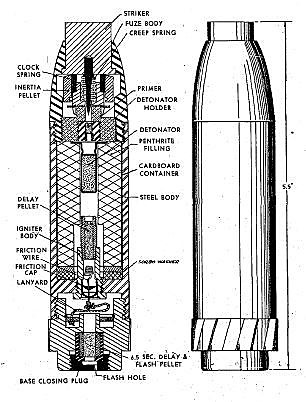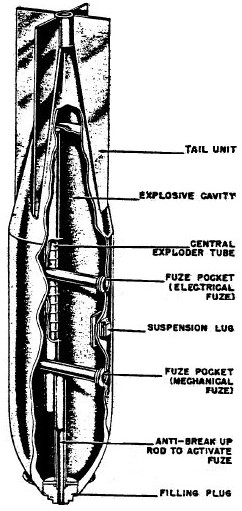
In an explosive, pyrotechnic device, or military munition, a fuse is the part of the device that initiates function. In common usage, the word fuse is used indiscriminately. However, when being specific, the term fuse describes a simple pyrotechnic initiating device, like the cord on a firecracker whereas the term fuze is used when referring to a more sophisticated ignition device incorporating mechanical and/or electronic components, such as a proximity fuze for an M107 artillery shell, magnetic or acoustic fuze on a sea mine, spring-loaded grenade fuze, pencil detonator, or anti-handling device.

An anti-handling device is an attachment to or an integral part of a landmine or other munition such as some fuze types found in general-purpose air-dropped bombs, cluster bombs and sea mines. It is designed to prevent tampering or disabling, or to target bomb disposal personnel. When the protected device is disturbed, it detonates, killing or injuring anyone within the blast area. There is a strong functional overlap of booby traps and anti-handling devices.

The Topfmines were a series of German circular minimum metal anti-tank blast mines that entered service with the German army in 1944, during the Second World War.

The Pappmine, or Cardboard Mine in English, was an anti-tank mine that was developed by Germany and used by the Wehrmacht during World War II.

The Mle 1939 was a French anti-personnel bounding mine used at the start of the Second World War, it was developed largely in response to the German S-mine bounding mine. It saw very little service before the fall of France. The plans escaped to the US via Major Pierre Delalande, a member of the French Corps of Engineers, and were used as the basis for the American M2 bounding mine which saw wider service during the war but was considered largely ineffective. The M2 mine was replaced almost immediately afterwards with the M16 bounding mine, an almost exact copy of the German S-mine. The French also later produced a copy of the S-mine, the Mle 1951 mine.

The L.P.Z. mine or Leichte Panzermine was a circular, metal-cased German anti-tank mine produced during the Second World War. The mine was accepted into service in 1941, and were intended for use by Paratroops. Production of the mine ended in 1942 with only 31,700 mines produced. The mines were first used during Operation Merkur, the airborne invasion of Crete and were still in use at the end of the war.

The SC 250 was an air-dropped general purpose high-explosive bomb built by Germany during World War II and used extensively during that period. It could be carried by almost all German bomber aircraft, and was used to notable effect by the Junkers Ju 87 Stuka. The bomb's weight was about 250 kg, from which its designation was derived.

A grenade is an explosive weapon typically thrown by hand, but can also refer to a shell shot from the muzzle of a rifle or a grenade launcher. A modern hand grenade generally consists of an explosive charge ("filler"), a detonator mechanism, an internal striker to trigger the detonator, an arming safety secured by a transport safety. The user removes the transport safety before throwing, and once the grenade leaves the hand the arming safety gets released, allowing the striker to trigger a primer that ignites a fuze, which burns down to the detonator and explodes the main charge.

Hexanitrodiphenylamine (abbreviated HND), is an explosive chemical compound with the formula C12H5N7O12. Since it is made from readily available raw materials, HND was used extensively by the Japanese and less extensively by Nazi Germany during World War II but was discontinued due to its toxicity.

The SC 1000 or cylindrical explosive bomb was a large air-dropped general-purpose thin-cased high explosive demolition bomb used by Germany during World War II. Weighing more than 1,000 kg (2,200 lb), it was nicknamed the Hermann by the Germans in reference to the Luftwaffe commander, Hermann Göring.

An artillery fuze or fuse is the type of munition fuze used with artillery munitions, typically projectiles fired by guns, howitzers and mortars. A fuze is a device that initiates an explosive function in a munition, most commonly causing it to detonate or release its contents, when its activation conditions are met. This action typically occurs a preset time after firing, or on physical contact with or detected proximity to the ground, a structure or other target. Fuze, a variant of fuse, is the official NATO spelling.
During the Second World War, the Luftwaffe developed a series of unguided rocket-propelled armor-piercing bombs. The three main types were the PC 500 Rs, PC 1000 Rs, and PC 1800 Rs. PC from Panzersprengbombe Cylindrisch the number from the approximate weight of the bomb in kilograms, and Rs meaning rocket propelled. These bombs were intended to be used against armored ships or similar targets. The purpose of the rocket propulsion was to increase the terminal velocity of the bomb and aid penetration.

The Gewehr-Sprenggranate was a high-explosive rifle grenade that was developed by Germany and used by the Wehrmacht during World War II.

The Wurfkörper 361 was a grenade that was developed by Germany and used by the Wehrmacht during World War II. The Wurfkörper 361 was designed to be fired from a Leuchtpistole or flare gun in English.

The Nebelpatrone or "fog cartridge" in English was a non-lethal smoke grenade that was developed by Germany and used by the Wehrmacht during World War II. The Nebelpatrone was designed to be fired from a Kampfpistole flare gun.

The Sprengpatrone or "explosive cartridge" in English was a rifle grenade that was developed by Germany and used by the Wehrmacht during World War II. The Sprengpatrone was designed to be fired from a Kampfpistole flare gun.

The Behelfs-Schützenmine S.150 was an anti-personnel mine that was developed by Germany and used by the Wehrmacht during World War II.

The Holzmine 42 was an anti-tank mine that was developed by Germany and used by the Wehrmacht during World War II.

The SB 1000 (Spezialbombe) was a luftmine used by the German Luftwaffe during World War II.

The SB 2500 (Spezialbombe) was a luftmine or aerial mine in English used by the Luftwaffe during World War II.





















